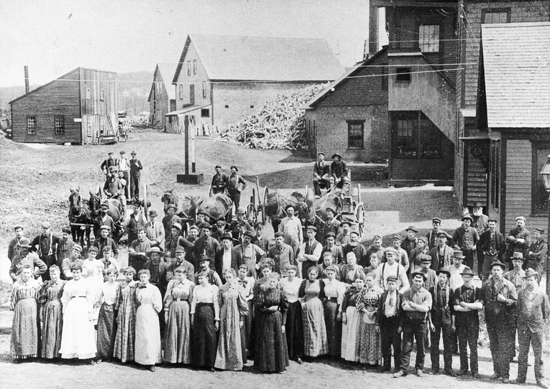B A C K T H E N
From Toothpicks to Legs

Strong. May 1897. Charles Forster’s toothpick (and cigar-lighter) factory. In 1883 the Strong firm of J.W. Porter and Sons made white-birch clothespins that were popular in Britain and China (clumsy English pins were described as looking like the “end of a hoe handle”), maple croquet sets (a single New York firm ordered 10,000), and ash baseball bats. Willow was the favorite wood for bats, but the supply was limited due to competition from manufacturers of artificial legs (no wood was said to equal willow for a wooden leg).
The original wooden toothpick man is said to be Charles Forster of Strong, Franklin County. He has done more for the teeth of America, it is said, than any other man under the sweep of her eagles’ wings. He whittled the original box of Yankee toothpicks, but he copied the art from natives of South America, where he was a merchant years ago. The South Americans picked their teeth with whittled-out splints. Forster sent a sample box to his wife ... as a curiosity. A hotel man got hold of them and sent to Forster for a box .... More orders came, and he began to get busy. Pretty soon he had natives whittling out toothpicks for hotels all over the United States. He moved home ... and in 1860 began making his toothpicks by machinery .... Now he sells 30,000 cases [containing 250,000 toothpicks each] a year. He is thought to make three-fifths of all the wooden toothpicks made in the country. With his primitive machinery a boy could grind out one toothpick at a time, while one operator can now turn out 15,000 a minute. He has sold $200,000 of them within the last two years. Twenty girls are kept busy every day packing them .... Forster is thought to have expended $50,000 on his patents in litigation ... The past year he worked up 1,000 cords of birch and poplar. The National Toothpick Association, which controls the production of toothpicks as the Standard Oil Trust does petroleum, has contracted for enough toothpicks to be made in Maine the coming year to load a freight train of fifty cars. — The [Bangor] Industrial Journal, August 5, 1887.
The toothpick trade has grown to enormous proportions ... It has not been many years since the big goose-quill was the only toothpick going. One of these hard picks from a goose would frequently last a man a week or so. He carried it in his waistcoat pocket, and instead of smoking ... he would draw forth his toothpick and snap it between his teeth .... In New York ... it is estimated that each hotel, as a rule, furnishes ten times the number of toothpicks to outsiders, those who are not guests ... every man who goes into a hotel leans over the counter, sees the box of toothpicks lying there and naturally picks up five or six .... — New York Mail and Express in The [Bangor] Industrial Journal, Nov. 5, 1886.
A noteworthy new industry [in Mechanic Falls] is the manufacture of toothpicks ... The wood is sawed into blocks the length of a pick, and then these blocks by the peeling process are converted into a ribbon of wood ... A block of wood eight inches in diameter will make a ribbon ninety feet in length. —The [Bangor] Industrial Journal, February 18, 1887.
At Forster’s the ribbon passed over two sharp blades of the finest steel, and was hit by a block of wood operating at 4,000 blows per minute. This machinery was designed by a Mr. Scammon, who also invented a drier and packer that did away with the work of twenty girls. Formerly, the picks that spewed forth from the machines were handled with pitchforks, dried in the sun like hay, and then sorted and packed with great labor.
Due to a lapse in the author’s filing system (?), this caption will not conclude with a sobering item concerning the horrible scalping of a young woman at Forster’s Strong mill – might we be looking at her here? – whose hair was caught in the machinery. Regarding the author and the toothpick, the former has learned by hard experience never to do business with a man who is worrying the latter in the corner of his mouth, especially if he is wearing tinted glasses and buying cattle.
A car containing 106,250,000 toothpicks was sent from Dixfield, Maine, to Ohio the other day. And yet the average Buckeye will continue to pick his teeth with a jackknife. — The [Bangor] Mining and Industrial Journal, April 25, 1884.
Text by William H. Bunting from A Days Work, Part 1, A Sampler of Historic Maine Photographs, 1860–1920, Part II. Published by Tilbury House Publishers, 12 Starr St., Thomaston, Maine. 800-582-1899.
